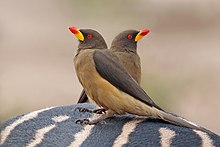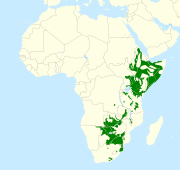
A passerine is any bird of the order Passeriformes which includes more than half of all bird species. Sometimes known as perching birds, passerines generally have an anisodactyl arrangement of their toes, which facilitates perching.

The Philippine creepers or rhabdornises are small passerine birds and form the genus Rhabdornis. They are endemic to the Philippines. They do not migrate, other than to make local movements.

The mimids are the New World family of passerine birds, Mimidae, that includes thrashers, mockingbirds, tremblers, and the New World catbirds. As their name suggests, these birds are notable for their vocalization, especially some species' remarkable ability to mimic a wide variety of birds and other sounds heard outdoors. They are commonly referred to as mimic thrushes but are not, in fact, thrushes.

Starlings are small to medium-sized passerine birds in the family Sturnidae common name of Sturnid Passerines are Starling Family The Sturnidae are named for the genus Sturnus, which in turn comes from the Latin word for starling, sturnus. The family contains 128 species which are divided into 36 genera. Many Asian species, particularly the larger ones, are called mynas, and many African species are known as glossy starlings because of their iridescent plumage. Starlings are native to Europe, Asia, and Africa, as well as northern Australia and the islands of the tropical Pacific. Several European and Asian species have been introduced to these areas, as well as North America, Hawaii, and New Zealand, where they generally compete for habitats with native birds and are considered to be invasive species. The starling species familiar to most people in Europe and North America is the common starling, and throughout much of Asia and the Pacific, the common myna is indeed common.

The brahminy starling or brahminy myna is a member of the starling family of birds. It is usually seen in pairs or small flocks in open habitats on the plains of the Indian subcontinent.

The white-faced starling is a member of the starling family of birds. It is an endemic resident breeder in Sri Lanka.

The yellow-billed oxpecker is a passerine bird in the family Buphagidae. It was previously placed in the starling and myna family, Sturnidae.

The red-billed oxpecker is a mutualistic passerine bird in the oxpecker family, Buphagidae. It is native to the eastern savannah of sub-Saharan Africa, from the Central African Republic east to South Sudan and south to northern and eastern South Africa. It is more widespread than the yellow-billed oxpecker in Southern Africa, where their ranges overlap.
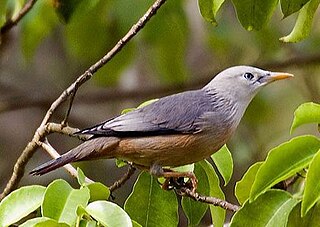
The Malabar starling is a species of starling found in southwestern India. It was previously considered a subspecies of the chestnut-tailed starling.

Acridotheres is a genus of starlings, the "typical" mynas, which are tropical members of the family Sturnidae.

Lamprotornis is a large genus of glossy-starlings all of which occur in Africa south of the Sahara. They have glossy blue or green upper parts, which is due to hollow melanin granules arranged in a single layer near the feather barbule's surface. This unique arrangement led to some glossy starlings formerly placed in the genus Spreo being transferred to Lamprotornis, since they shared this feature.
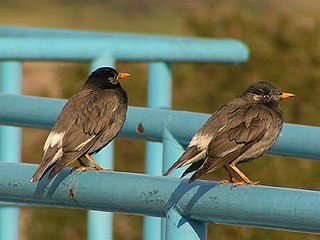
The white-cheeked starling or grey starling is a passerine bird of the starling family. It is native to eastern Asia where it is a common and well-known bird in much of its range.

The white-headed starling, also known as the Andaman white-headed starling, is a species of starling in the family Sturnidae. It is found in wooded habitats of the Andaman and Nicobar Islands.

The black-collared starling is a species of starling in the family Sturnidae. Its plumage is black and white, with a black collar. It is found in southern China and most of mainland Southeast Asia, and has been introduced to Taiwan, Malaysia and Singapore. Its habitats include grassland, dry forest and human settlements. The International Union for Conservation of Nature (IUCN) has assessed it as being of least concern.
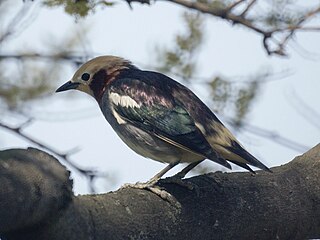
The chestnut-cheeked starling is a species of starling in the family Sturnidae. It breeds in Japan and the Russian islands of Sakhalin and Kuriles; it winters in Taiwan, the Philippines and northern Borneo.

The red-billed starling is a species of starling in the family Sturnidae. It is found in south and southeastern China.

The white-shouldered starling is a species of bird in the starling family Sturnidae. It breeds in southern China and northern Vietnam; it winters in Southeast Asia.

The Daurian starling, or purple-backed starling, is a species of bird in the starling family found in the eastern Palearctic from eastern Mongolia and southeastern Russia to North Korea and central China.

Agropsar is a genus of Asian birds in the family Sturnidae. It is sometimes merged with Sturnus or Sturnia

Muscicapida is a clade of birds in the order Passeriformes. Oliveros, C.H. et al. (2019) suggested a gondwanan migration of this lineage from Australia to Eurasia.
